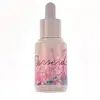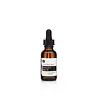What's inside
What's inside
 Key Ingredients
Key Ingredients

 Benefits
Benefits

 Concerns
Concerns

 Ingredients Side-by-side
Ingredients Side-by-side

Persea Gratissima Oil
Skin ConditioningLimnanthes Alba Seed Oil
Skin ConditioningOryza Sativa Bran Oil
EmollientSimmondsia Chinensis Seed Oil
EmollientCommiphora Abyssinica Gum Oil
PerfumingOenothera Biennis Oil
EmollientMacadamia Ternifolia Seed Oil
EmollientRicinus Communis Seed Oil
MaskingSqualane
EmollientBorago Officinalis Seed Oil
EmollientBanksia Serrata Seed Oil
AntioxidantVaccinium Macrocarpon Seed Oil
Skin ConditioningPunica Granatum Seed Oil
EmollientRubus Idaeus Seed Oil
EmollientRosa Rubiginosa Seed Oil
EmollientHippophae Rhamnoides Oil
EmollientArgania Spinosa Kernel Oil
EmollientTocopherol
AntioxidantBisabolol
MaskingRose Extract
Skin ConditioningPersea Gratissima Oil, Limnanthes Alba Seed Oil, Oryza Sativa Bran Oil, Simmondsia Chinensis Seed Oil, Commiphora Abyssinica Gum Oil, Oenothera Biennis Oil, Macadamia Ternifolia Seed Oil, Ricinus Communis Seed Oil, Squalane, Borago Officinalis Seed Oil, Banksia Serrata Seed Oil, Vaccinium Macrocarpon Seed Oil, Punica Granatum Seed Oil, Rubus Idaeus Seed Oil, Rosa Rubiginosa Seed Oil, Hippophae Rhamnoides Oil, Argania Spinosa Kernel Oil, Tocopherol, Bisabolol, Rose Extract
Simmondsia Chinensis Seed Oil
EmollientBorago Officinalis Seed Oil
EmollientPersea Gratissima Oil
Skin ConditioningLimnanthes Alba Seed Oil
Skin ConditioningArgania Spinosa Kernel Oil
EmollientRosa Rubiginosa Seed Oil
EmollientActinidia Chinensis Seed Oil
EmollientCalophyllum Inophyllum Seed Oil
AntimicrobialOlea Europaea Fruit Oil
MaskingSalvia Hispanica Seed Oil
MoisturisingRubus Idaeus Seed Oil
EmollientSesamum Indicum Seed Oil
EmollientSambucus Nigra Extract
Skin ConditioningTocopherol
AntioxidantCamellia Oleifera Seed Oil
Skin ConditioningPunica Granatum Seed Oil
EmollientOpuntia Ficus-Indica Seed Oil
EmollientAstaxanthin
Skin ConditioningLavandula Angustifolia Oil
MaskingPelargonium Graveolens Oil
MaskingDocosahexaenoic Acid
Skin ConditioningBrassica Oleracea Italica Seed Oil
EmollientSolanum Lycopersicum Seed Oil
EmollientCitrus Aurantium Peel Oil
Helichrysum Italicum Flower Oil
MaskingRosmarinus Officinalis Leaf Extract
AntimicrobialMyrtus Communis Oil
MaskingSimmondsia Chinensis Seed Oil, Borago Officinalis Seed Oil, Persea Gratissima Oil, Limnanthes Alba Seed Oil, Argania Spinosa Kernel Oil, Rosa Rubiginosa Seed Oil, Actinidia Chinensis Seed Oil, Calophyllum Inophyllum Seed Oil, Olea Europaea Fruit Oil, Salvia Hispanica Seed Oil, Rubus Idaeus Seed Oil, Sesamum Indicum Seed Oil, Sambucus Nigra Extract, Tocopherol, Camellia Oleifera Seed Oil, Punica Granatum Seed Oil, Opuntia Ficus-Indica Seed Oil, Astaxanthin, Lavandula Angustifolia Oil, Pelargonium Graveolens Oil, Docosahexaenoic Acid, Brassica Oleracea Italica Seed Oil, Solanum Lycopersicum Seed Oil, Citrus Aurantium Peel Oil, Helichrysum Italicum Flower Oil, Rosmarinus Officinalis Leaf Extract, Myrtus Communis Oil
Ingredients Explained
These ingredients are found in both products.
Ingredients higher up in an ingredient list are typically present in a larger amount.
You may know this ingredient as argan oil. Argan Oil has antioxidant, hydrating, and soothing properties.
Studies have shown argan oil can help fight again radical damage from the sun. This makes it effective at preventing hyperpigmentation.
Large amounts of vitamin E found in argan oil helps the skin retain water. Argan oil also contains fatty acids such as linoleic acid, oleic acid, and palmitic acid. It is also a good source of lipids.
Another benefit of argan oil is skin-soothing. It can help reduce inflammation-related skin symptoms.
Argan Oil is effective at regulating sebum production in pores. This can make it effective at treating hormonal acne.
Traditionally, argan oil was used for its antibacterial and antifungal properties. However, argan oil contains fatty acids that may make it not fungal-acne safe.
Argan Trees are native to Morocco.
Learn more about Argania Spinosa Kernel OilBorago Officinalis Seed Oil is from the seeds of the starflower plant. This plant grows primarily in Europe.
This oil does not have a scent. It contains fatty acids such as linolenic acid. These fatty acids help keep skin hydrated.
Borago Officinalis Seed Oil is an antioxidant. Antioxidants help fight free-radicals. Free-radicals are molecules that may damage your skin cells.
Learn more about Borago Officinalis Seed OilLimnanthes Alba Seed Oil is the oil extracted from the seeds of the meadowfoam plant. This oil is non-fragrant and is an emollient. As an emollient, meadowfoam seed oil helps soften and hydrate the skin.
Meadowfoam seed oil is stable and has a long shelf life due to its chemical structure. It has the highest concentration of stable fatty-acids among plant oils, preventing it from degrading once exposed to oxygen.
Due to the fatty acid content, this ingredient may not be fungal-acne safe.
Meadowfoam is native to California and Oregon.
Learn more about Limnanthes Alba Seed OilPersea Gratissima Oil is also known as avocado oil.
Avocado Oil has antioxidant properties. It is mostly made up of the glycerides of fatty acids. About 67% of these fatty acids is made up of oleic acid. Palmitic acid and linoleic acid are also present.
These fatty acids help hydrate and soften the skin. It may increase collagen content in the skin. Collagen helps keep your skin plump and firm. This ingredient helps reduce inflammation and has not shown to clog pores.
This ingredient may not be fungal-acne safe due to its high fatty acid content.
Avocados also have B vitamins, vitamin K, vitamin C, vitamin E, and potassium.
Learn more about Persea Gratissima OilPunica Granatum Seed Oil is created from the seeds of the pomegranate. Pomegranate seed oil helps hydrate the skin, is anti-inflammatory, and contains antioxidants.
Pomegranates are rich in fatty acids, including an unsaturated fatty acid by the name of Punicic acid. Other components of pomegranates include Vitamin E, Vitamin C, and bioactive lipids such as phytosterols, phospholipids, and triterpenes. Punicic acid helps soothe inflammation.
As an emollient, pomegranate oil creates a thin film on the skin. This film helps prevent moisture loss, keeping your skin hydrated.
Learn more about Punica Granatum Seed OilRosehip oil is an emollient. It comes from the sweet-brier plant native to Europe and western Asia.
This ingredient is rich in Vitamin E, Vitamin C, linoleic acid, and other fatty acids, making it a great skin hydrator.
Another component of Rosa Rubiginosa is tretinoin, or trans-retinoic acid. Tretinoin is an anti-aging ingredient. However, the efficacy of this tretinoin depends on how the oil is extracted.
Due to the rich fatty acid content, this ingredient may not be fungal-acne safe.
Learn more about Rosa Rubiginosa Seed OilRubus Idaeus Seed Oil is created from the seeds of the raspberry fruit. Raspberries are native to northern Europe and Asia.
Raspberry seed oil is an emollient with antioxidant and anti-inflammatory properties. It is rich in fatty acids, tocopherols, flavonoids, Vitamin C, and Vitamin E.
As an emollient, raspberry seed oil helps hydrate your skin. Emollients prevent moisture from evaporating by creating a film on top.
Learn more about Rubus Idaeus Seed OilThis oil comes from the seeds of the desert shrub called Jojoba. It is more commonly known as jojoba oil, a non-comedogenic oil.
Jojoba oil does not contain fragrance and has many fatty-acids, making it a great soothing ingredient.
It also contains Vitamin E, a great moisturizing ingredient. Vitamin E is also an antioxidant and protects your skin against oxidative damage.
This ingredient humectant properties, meaning it helps draw moisture from the air. This helps keep your skin hydrated.
While jojoba has antibacterial properties, it is only able to kill some strains of bacteria.
Studies also show it helps in wound healing. In fact, Indigenous cultures have used jojoba as a moisturizer and to help treat burns for centuries.
Fun fact: Jojoba oil similar to natural human skin sebum, so it has a great effect on dry skin. It is also promising with helping to regulate sebum production.
Due to its fatty acid content, Jojoba oil may not be fungal acne safe. We recommend speaking with a professional if you have any concerns.
Learn more about Simmondsia Chinensis Seed OilTocopherol (also known as Vitamin E) is a common antioxidant used to help protect the skin from free-radicals and strengthen the skin barrier. It's also fat soluble - this means our skin is great at absorbing it.
Vitamin E also helps keep your natural skin lipids healthy. Your lipid skin barrier naturally consists of lipids, ceramides, and fatty acids. Vitamin E offers extra protection for your skin’s lipid barrier, keeping your skin healthy and nourished.
Another benefit is a bit of UV protection. Vitamin E helps reduce the damage caused by UVB rays. (It should not replace your sunscreen). Combining it with Vitamin C can decrease sunburned cells and hyperpigmentation after UV exposure.
You might have noticed Vitamin E + C often paired together. This is because it is great at stabilizing Vitamin C. Using the two together helps increase the effectiveness of both ingredients.
There are often claims that Vitamin E can reduce/prevent scarring, but these claims haven't been confirmed by scientific research.
Learn more about Tocopherol